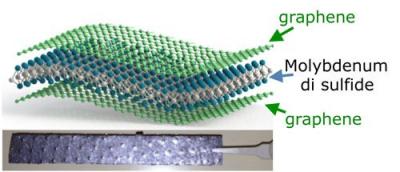Researchers from Kansas State University developed a new composite paper made of interleaved molybdenum disulfide and graphene nanosheets that can be used as a negative electrode in sodium-ion batteries. The researchers say that the paper can be both an active material to efficiently store sodium atoms and a flexible current collector.

The researchers say that regular negative electrodes for sodium-ion batteries use materials that undergo an 'alloying' reaction with sodium. This means that the materials can swell as much as 400 to 500 percent as the battery is charged and discharged - which is problemtic as it can cause mechanical damage and loss of electrical contact with the current collector.
The Molybdenum disulfide offers a new kind of chemistry with sodium ions, which is a combination of intercalation and a conversion-type reaction. The researchers report that the electrode offers stable charge capacity of 230 mAh.g-1, with respect to total electrode weight. Further, the interleaved and porous structure of the paper electrode offers smooth channels for sodium to diffuse in and out as the cell is charged and discharged quickly. This design also eliminates the polymeric binders and copper current collector foil used in a traditional battery electrode.
The researchers now want to commercialize this technology with assistance from the University's Institute of Commercialization.

